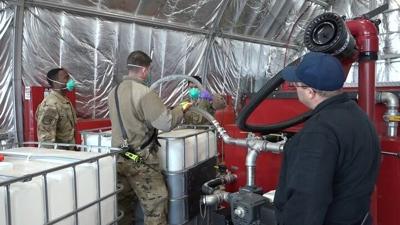By Mollie Miller
Air Force Installation and Mission Support Center Public Affairs
JOINT BASE SAN ANTONIO-LACKLAND, Texas — Department of the Air Force installation fire departments are replacing current stocks of aqueous film forming foam, or AFFF, in fire and emergency services vehicles with a fluorine-free formulation as part of a Defense Department-wide effort to remove PFAS from firefighting activities.
The Air Force has committed $8.55 million to purchase more than 270,000 gallons of the new fluorine-free foam, or F3. Overseas installations were the first to receive the new foam, and Tyndall Air Force Base, Fla., took delivery in early January.
AFFF is a fire suppressant used in the past by industry, commercial aviation, and military services to combat fuel fires. The foam contains per- and poly-fluoroalkyl substances, or PFAS. PFAS do not break down easily in the environment, and have been shown to accumulate in the body, and some studies suggest exposure to high levels of certain PFAS may lead to adverse health outcomes.
Unlike AFFF, fluorine-free foam does not persist in the environment, accumulate in the body, or cause toxic effects, according to current research.
“The Department of the Air Force’s top priority is the health and safety of our Airmen and Guardians, their families, and our community partners,” said Nancy Balkus, Deputy Assistant Secretary of the Air Force for Environment, Safety, and Infrastructure. “We are implementing multiple initiatives to address PFAS impacts and this new fluorine-free firefighting foam transition is one key component.”
The 2020 National Defense Authorization Act required the DoD to phase out AFFF by Oct. 1, 2024, with the possibility of two one-year extensions. John P. Smith III, a program manager at the Air Force Civil Engineer Center who is overseeing the Air Force’s foam transition, said that meeting the requirements of the NDAA is well within the reach of the active-duty installations.
“So far everything for the active Air Force and Space Force AFFF to F3 transition is going according to expectations,” he said. “We are confident active locations will meet the deadline.”
The F3 arriving at active-duty installations is to eliminate AFFF from all Fire and Emergency Services mobile assets. The amount ordered for each location accounts for one full foam replacement in the emergency vehicles plus one complete refill backstock, Smith said.
“We want to make sure the installations have enough F3 available onsite should they have to empty the trucks during an emergency,” he said. “We don’t want them to run out and have to wait on another shipment.”
Kevin Gabos, AFCEC Hazardous Material and Hazardous Waste subject matter expert, said the F3 transition involves more than just replacing one foam with another. Eliminating AFFF from emergency response vehicles requires multiple steps and coordination among installation emergency response and environmental personnel, the Air Force Installation and Mission Support Center, the Defense Logistics Agency and others.
“It has been a team of many teams ensuring the success of this process,” Gabos said. “Everyone has been very willing to put in the work to make sure this transition gets done right.”
Senior Airman Nathan Guess, a firefighter in Tyndall’s 325th Civil Engineer Squadron, was part of the service’s first foam swap operation.
“(Firefighters) are a family and switching out this foam is a way we can protect our family,” he said.
Smith, who spent 26 years as an active-duty Air Force firefighter, said the transition is an important step in the service’s effort to protect its people and the environment.
“This swap really is a dual benefit,” he said. “We are looking out for the health of our firefighters while at the same time caring for the environment.”
The mobile asset foam swap comes just months after the Air Force disconnected and locked out AFFF tanks connected to nearly all the service’s hangar fire suppression systems.
“The health of our Airmen, Guardians, families and community partners is a top priority,” said Michael Six, AFCEC chief fire protection engineer,n.
The emergency vehicle transition to F3 at active installations is expected to conclude by late summer. The removed AFFF will be solidified and disposed of in a landfill with impervious liners and leachate collection systems as permitted under the Resource Conservation and Recovery Act.
Ensuring first responders have experience with F3 is also an important training milestone, Balkus said. Air Force and DoD teams are working to refine F3 tactics, techniques and procedures.






















Commented
Sorry, there are no recent results for popular commented articles.